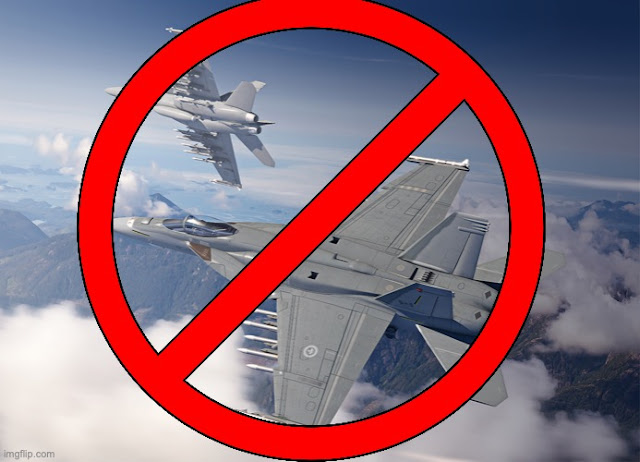SUPER HORNET IS OUT. BOEING HAS NO ONE TO BLAME BUT ITSELF.
Reports that there would be a "down selection" in the competition to replace Canada's aging CF-18s have turned out to be true... Sort of.
Despite "industry insiders" predicting that the Saab Gripen will be removed from consideration, that dubious honor will go to Boeing's Super Hornet instead. This is indeed a big surprise... If you have not been paying attention.
The most striking fact about the Super Hornet's departure is that, at one point, it WAS going to be Canada's next fighter. Well... On an interim basis, anyway. When the Liberal government formed in 2015, they had done so on the promise of cancelling Canada's F-35 purchase. The F/A-18E/F seemed to be the most likely alternative. In 2016, it was announced that Canada would be purchasing 18 Super Hornets as a way of filling a "capability gap". While these 18 Super Hornets would not be a replacing CF-18s per se, they could have definitely been used a reason to single-source a full Rhino buy later on in the interest of commonality and cost savings.
All Boeing really had to do is sit back, relax, and keep its St. Louis assembly line running. Instead, Boeing decided to bite the hand about to feed it.
After years of struggling with their ambitious C-Series airliner, Bombardier was finally seeing some success. Having recently secured orders from Delta Airlines, it was starting to look like the jetliner was ready for prime-time.
What made the C-Series special was its 3+2 across seating. Bigger than jetliners like the Embraer E-Jet and Bombardier's own CRJ, yet smaller than the ubiquitous Boeing 737 and Airbus A320; the C-Series promised to fill an emerging niche. Increased security measures in a post-9/11 airline industry had left travelers preferring direct flights over the "hub-and-spoke" model. This led to slump in "jumbo" jets designed specifically to travel between hubs, effectively killing off both the Airbus A380 and Boeing 747. Smaller, more flexible airliners are all the rage now.
Sensing potential competition to its bread-and-butter 737 and its upcoming MAX variant, Boeing decided to build a superior competing product dispatch its team of lawyers and lobbyists with a sole goal of killing the C-Series. Having the ear of the nationalistic Trump administration, Boeing had no problem convincing the US Government to impose a 220% tariff on the C-Series, effectively killing any hope of American sales. This decision was eventually overturned, but the writing was on the wall for financially-strapped Bombardier. Left with little other choice, Bombardier sold control of the C-Series to Airbus and had decided to leave the commercial jetliner business altogether.
The whole debacle has left a permanent scar on Canada's aerospace industry. Enough so that the Trudeau Government not only cancelled the interim Super Hornet purchase, but added a "trusted partner" clause to the FFCP.
Ironically, Boeing's biggest challenge to the 737 MAX was the 737 MAX itself. Several high-profile crashes revealed that the MAX itself was rushed into production with plenty of corners cut. Boeing was then hit by the COVID-19 pandemic as demand for airliners in general dried up. At least they had their military arm to prop them up...
Oh... About that...
Boeing is still having issues with its KC-46 Pegasus tanker. Being a "fixed price" contract, Boeing will be on the hook for over $5 billion in cost overruns.
Despite heavy promotion of its "Block III" Super Hornet, the USN has decided that it will simply upgrade older Rhinos to the standard instead of purchasing new airframes. Just as well, as it seems the Block III improvements promised with the "International Roadmap Edition" were simply not to be. First to get dropped were the novel enclosed weapon pods (remember those?) followed by the conformal fuel tanks. As of now, the Block III Rhino looks like a regular Super Hornet with an upgraded cockpit and a kludgy combination IRST/drop tank.
Thankfully for Boeing, its T-7 Red Hawk trainer is proceeding mostly as planned. This is likely due to the assistance of Saab, who partnered with Boeing on the project due to their expertise in developing low-cost fighters. Boeing also has its new F-15EX Eagle II, which will see at least 144 sold to the USAF.
Canada's rejection of the Super Hornet deals it an enormous blow. Aside from the USN, Canada was the most promising buyer of new Rhinos. Boeing may find other buyers, but competition is fierce and any sales will likely be in limited numbers. Germany is the next likely customer, but it is still committed to the Eurofighter Typhoon.
With a dearth in potential customers, Boeing may soon have little choice but to end F/A-18E/F production altogether. This is unfortunate. A few short years ago, it looked like the Super Hornet Block III would not only be Canada's next fighter, but the default choice for air forces not ready to commit to the F-35. Instead, both the Hornet and Super Hornet will fail to outlive the older F-15 Eagle.
On paper, the F/A-18E/F Super Hornet seemed to be a great fit for Canada. While not as "sexy" as the Eurocanards nor as cutting edge as the F-35; the Rhino had a reputation for being a reliable "no frills" workhorse. Until the infamous Boeing/Bombardier dispute, it was clearly the "safest choice". Afterwards, it became political poison. Any government rewarding Boeing with a $19 billion contract would face immediate derision by opposing political parties and voters alike. With the latest Federal election resulting in (another) minority government; Boeing never really had a chance. A hard pill to swallow after almost being a shoe-in.
Put simply, Boeing managed to snatch defeat from the jaws of victory.







Comments
Post a Comment